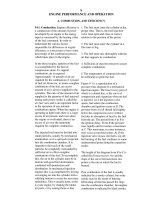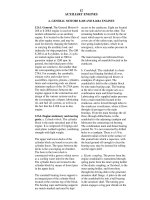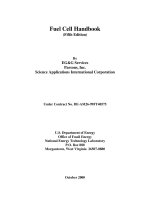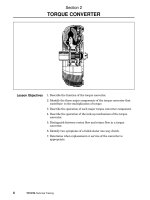Tài liệu Rolling bearings P2 docx
Bạn đang xem bản rút gọn của tài liệu. Xem và tải ngay bản đầy đủ của tài liệu tại đây (365.71 KB, 20 trang )
Schaeffler Group Industrial HR 1 31
Page
Fitting and dismantling
Handling ................................................................................ 167
Storage of rolling bearings ................................................. 167
Unpacking of rolling bearings ............................................ 168
Compatibility, miscibility ................................................... 168
Cleaning of rolling bearings ............................................... 168
Fitting ..................................................................................... 169
Guidelines for fitting .......................................................... 169
Fitting of rolling bearings with cylindrical seats .................. 170
Fitting of rolling bearings with tapered bore ....................... 173
Guidelines for dismantling ................................................. 174
Dismantling of rolling bearings on cylindrical seats ............ 175
Dismantling of rolling bearings with tapered bore .............. 177
32 HR 1 Schaeffler Group Industrial
Load carrying capacity and life
Schaeffler KG introduced the “Expanded calculation of the adjusted
rating life” in 1997. This method is standardised in accordance
with DIN ISO 281, Appendix 1. The method will be incorporated in
the next version of the international standard ISO 281.
Fatigue theory as a principle
The basis of the rating life calculation in accordance with ISO 281
is Lundberg and Palmgren’s fatigue theory which always gives a final
rating life.
However, modern, high quality bearings can exceed by
a considerable margin the values calculated in accordance with
ISO 281 under favourable operating conditions. Ioannides and
Harris have developed a further model of fatigue in rolling contact
that expands on the Lundberg/Palmgren theory and gives a better
description of the performance capability of modern bearings.
The method “Expanded calculation of the adjusted rating life” takes
account of the following influences:
■ the bearing load
■ the fatigue limit of the material
■ the extent to which the surfaces are separated by the lubricant
■ the cleanliness in the lubrication gap
■ additives in the lubricant
■ the internal load distribution and frictional conditions in
the bearing.
Caution! The influencing factors, especially those relating to contamination,
are extremely complex. A great deal of experience is essential for
an accurate assessment. For further advice, we recommend that you
consult the engineering service of Schaeffler Group Industrial.
The tables and diagrams can give only guide values.
Schaeffler Group Industrial HR 1 33
Dynamic load
carrying capacity and life
The required size of a rolling bearing is dependent on the demands
made on its:
■ load carrying capacity
■ rating life
■ operational reliability.
The dynamic load carrying capacity is described in terms of the basic
dynamic load ratings. The basic dynamic load ratings are based on
DIN ISO 281.
The basic dynamic load ratings for rolling bearings are matched
to contemporary performance standards and those published in
previous FAG and INA catalogues.
The fatigue behaviour of the material determines the dynamic load
carrying capacity of the rolling bearing.
The dynamic load carrying capacity is described in terms of the basic
dynamic load rating and the basic rating life.
The rating life as a fatigue period depends on:
■ the load
■ the operating speed
■ the statistical probability of the first appearance of failure.
The basic dynamic load rating C applies to rotating rolling bearings.
It is:
■ a constant radial load C
r
for radial bearings
■ a constant, concentrically acting axial load C
a
for axial bearings.
The basic dynamic load rating C is that load of constant magnitude
and direction which a sufficiently large number of apparently
identical bearings can endure for a basic rating life of one million
revolutions.
34 HR 1 Schaeffler Group Industrial
Load carrying capacity and life
Calculation of the rating life
The methods for calculating the rating life are:
■ the basic rating life to DIN ISO 281, page 34
■ the adjusted rating life to DIN ISO 281, page 35
■ the expanded adjusted rating life to DIN ISO 281, Appendix 1,
page 38.
Basic rating life
The basic rating life L and L
h
is determined using the following
formulae:
L10
6
revolutions
The basic rating life in millions of revolutions is the life reached or exceeded
by 90% of a sufficiently large group of apparently identical bearings before
the first evidence of material fatigue develops
L
h
h
The basic rating life as defined for L but expressed in operating hours
CN
Basic dynamic load rating
PN
Equivalent dynamic bearing load for radial and axial bearings
(see also Equivalent operating values, page 42 and page 43)
p–
Life exponent;
for roller bearings: p = 10/3
for ball bearings: p =3
nmin
–1
Operating speed
(see also Equivalent operating values, page 42 and page 43).
Equivalent dynamic load The equivalent dynamic load P is a calculated value. This value is
constant in size and direction; it is a radial load for radial bearings
and an axial load for axial bearings.
P gives the same rating life as the combined load occurring in
practice.
PN
Equivalent dynamic bearing load
F
r
N
radial dynamic bearing load
F
a
N
axial dynamic bearing load
X–
Radial factor given in the dimension tables or product description
Y–
Axial factor given in the dimension tables or product description.
Caution! This calculation cannot be applied to radial needle roller bearings,
axial needle roller bearings and axial cylindrical roller bearings.
Combined loads are not permissible with these bearings.
Equivalent values for non-constant loads or speeds:
see Equivalent operating values, page 42 and page 43.
L
C
P
p
=
⎛
⎝
⎜
⎞
⎠
⎟
L
n
C
P
h
p
=⋅
⎛
⎝
⎜
⎞
⎠
⎟
16666
PXF YF
ra
=⋅+⋅
Schaeffler Group Industrial HR 1 35
Adjusted rating life
The adjusted rating life can be calculated if, in addition to the load
and speed, other influences are known such as:
■ special material characteristics
■ lubrication
or
■ if a requisite reliability other than 90% is specified.
L
na
10
6
revolutions
Adjusted rating life for special material characteristics and
operating conditions with a requisite reliability of (100 – n) %
L10
6
revolutions
Basic rating life
a
1
–
Life adjustment factor for a requisite reliability other than 90%,
table Life adjustment factor a
1
a
2
–
Life adjustment factor for special material characteristics –
for standard rolling bearing steels: a
2
=1
a
3
–
Life adjustment factor for special operating conditions –
in particular lubrication, Figure 1.
The viscosity ratio is determined according to the formula on
page 36.
Life adjustment factor a
1
LaaaL
na
=⋅⋅⋅
123
Requisite reliability 90% 95% 96% 97% 98% 99%
Life adjustment factor a
1
1 0,62 0,53 0,44 0,33 0,21
a
3
= life adjustment factor
= viscosity ratio
ᕃ Good cleanliness and suitable additives
ᕄ Very high cleanliness and low load
ᕅ Contamination in the lubricant
Figure 1
Life adjustment factor a
3
10
5
2
1
0,5
0,2
0,1
0,05
0,1 0,2 0,5 1 2 5 10
a
3
3
1
2
151 068a
36 HR 1 Schaeffler Group Industrial
Load carrying capacity and life
Viscosity ratio The viscosity ratio is an indication of the quality of lubricant film
formation:
mm
2
s
–1
Kinematic viscosity of the lubricant at operating temperature
1
mm
2
s
–1
Reference viscosity of the lubricant at operating temperature.
The reference viscosity
1
is determined from the mean bearing
diameter d
M
= (D + d)/2 and the operating speed n,
Figure 2, Reference viscosity
1
, page 37.
The nominal vicosity of the oil at +40 °C is determined from
the required operating viscosity and the operating temperature ,
Figure 3, V/T diagram for mineral oils, page 37. In the case of
greases, is the operating viscosity of the base oil.
In the case of heavily loaded bearings with a high proportion of
sliding contact, the temperature in the contact area of the rolling
elements may be up to 20 K higher than the temperature measured
on the stationary ring (without the influence of any external heat).
Caution! Taking account of EP additives in calculation of the expanded
adjusted rating life L
nm
: see page 38.
=
1
Schaeffler Group Industrial HR 1 37
1
= reference viscosity
d
M
= mean bearing diameter
n = speed
Figure 2
Reference viscosity
1
10
20 50 100 200 500 1000
3
5
10
20
50
100
200
500
1000
mm s
2
mm
M
n
100000
50000
20000
10000
5000
1000
2000
500
200
100
50
20
10
5
2
1
min
–1
Ϫ1
d
151 157a
= operating viscosity
= operating temperature
40
= viscosity at +40 °C
Figure 3
V/T diagram for mineral oils
ISO-VG
10
20 30 40 50 60 70 80 100 120˚C
10
20
100
200
300
1000
mm s
2 Ϫ1
40
15
22
32
46
68
100
150
220
320
460
680
1000
1500
3
5
50
10
151 157b
38 HR 1 Schaeffler Group Industrial
Load carrying capacity and life
Expanded adjusted rating life
The expanded adjusted rating life is calculated according to
the following formula:
L
nm
10
6
revolutions
Expanded adjusted rating life to DIN ISO 281, Appendix 1.
This appendix defines manual calculation at the catalogue level;
computer-aided calculation is standardised in DIN ISO 281, Appendix 4
a
1
–
Life adjustment factor for a requisite reliability other than 90%,
table Life adjustment factor a
1
, page 35
a
DIN
–
Life adjustment factor for operating conditions, see formula below
L10
6
revolutions
Basic rating life, page 34.
Life adjustment factor a
DIN
The standardised method for calculating the life adjustment
factor a
DIN
essentially takes account of the following influences:
■ the load on the bearing
■ the lubrication conditions –
viscosity and type of lubricant, speed, bearing size, additives
■ the fatigue limit of the material
■ the type of bearing
■ the residual stress in the material
■ the environmental conditions
■ contamination in the lubricant.
a
DIN
–
Life adjustment factor for operating conditions, see Figure 4 to Figure 7
e
C
–
Life adjustment factor for contamination, see table, page 41
C
u
N
Fatigue limit load, according to dimension tables
PN
Equivalent dynamic bearing load
–
Viscosity ratio, see page 36
For Ͼ4 calculation should be carried out using =4.
This calculation method cannot be used for Ͻ0,1.
Taking account of EP additives DIN ISO 281, Appendix 1, describes how EP additives are taken into
consideration. For a viscosity ratio Ͻ1 and a contamination
factor e
C
м 0,2, calculation can be carried out using the value =1
for lubricants with EP additives that have been proven effective.
With severe contamination (contamination factor e
C
Ͻ 0,2), the
effectiveness of the additives under these contamination conditions
must be proven. The effectiveness of the EP additives can be
demonstrated in the actual application or on a rolling bearing test
rig FE 8 to DIN 51819-1.
If the EP additives are proven effective and calculation is carried out
using the value = 1, the life adjustment factor must be restricted
to a
DIN
Ϲ 3. If the calculated value a
DIN
for the actual is greater
than 3, this value can be used in calculation.
LaaL
nm DIN
=⋅ ⋅
1
af
eC
P
DIN
Cu
=
⋅
⎡
⎣
⎢
⎤
⎦
⎥
,









